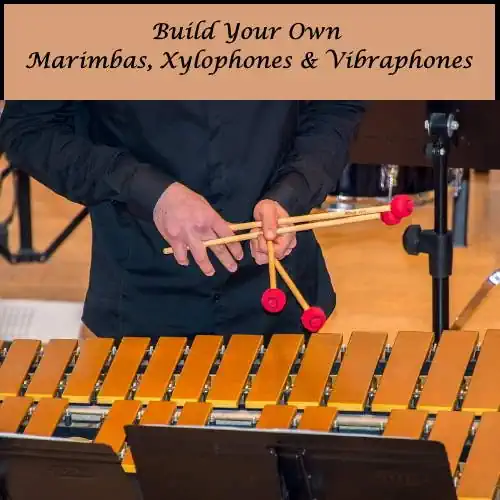Description
Make a Marimba is a collection of comprehensive plans to build your own xylophones, marimbas, vibraphones, and other commercial-quality percussion instruments.
With this DIY guide, you’ll uncover the step-by-step process of marimba building, from selecting premium materials to fine-tuning the instrument’s resonance.
But there’s more to this journey than just the end product – discover the unexpected benefits that come with crafting your own marimba and the potential cost savings that await you.
Cost Comparison of Marimba Building Vs. Commercial Instruments
Crafting your own marimba can provide a cost-effective alternative to purchasing a commercial instrument, saving you significant amounts of money while still achieving professional sound quality. The cost benefits are substantial, with student model marimbas costing around $2750 (USD) and professional five-octave marimbas closer to $20,000. In comparison, building your own marimba can be significantly cheaper, especially when considering the price of materials and tools.
The materials cost depends on the type of instrument being built, and plans include both imperial and metric measurements. Basic woodworking skills are sufficient, and common household tools are all that’s needed, making it a practical and budget-friendly option.
With attention to detail and precision, you can achieve quality sound with homemade instruments, making the cost benefits even more appealing.
Achieving Quality Sound With Homemade Marimbas
To achieve quality sound with homemade marimbas, focus on selecting the appropriate timber and meticulously tuning the bars for optimal resonance.
When tuning the bars, use tuning techniques such as tuning by ear or with a basic electronic tuner, and consider using Peterson tuning software for professional results.
The importance of resonator materials in homemade marimbas can’t be overstated, as they play a crucial role in amplifying the sound. Consider using PVC pipe for resonators, as it’s lightweight, inexpensive, and easy to work with, providing flexibility in material choice.
Do I need special materials for the bars?
No, you can use various types of wood or standard metal stock. For higher quality, you can choose Honduras Rosewood or African padauk, but most hardwoods are suitable.
How much do the materials typically cost?
Costs vary by instrument and region, but here are some estimates:
-
- Simple Glockenspiel: $20
- P1 Xylophone: $33
- P2 Mini-Marimba: $250
- P3 Marimba: $400
- P524 Marimba: $1700 (using African Padauk bars)
- PV Vibraphone: $600
Total Building Package and Bonuses
As you pursue the art of crafting quality sound with homemade marimbas, the next step is to explore the comprehensive Total Building Package and its accompanying bonuses, which will provide you with a wealth of instructional resources and support for your instrument-building journey.
How Much Does Make A Marimba Cost?
The Total Building Package includes over three hours of instructional videos, bonus sheet music pieces, a mallet-making guide, and Percussion Keys membership. This package offers great value and savings.
The total package, including the bonuses, is $173, but you can purchase the individual sets of instructions for $9.95-64.95.

By using these products, you can save thousands of dollars, have a range of professional mallet instruments, and achieve high proficiency in instrument building.
Do I need to be skilled in woodworking?
No, basic woodworking skills like measuring, cutting, and sanding are sufficient. The guides are designed to be easy to follow, even for beginners.
Is special tuning equipment required?
While not mandatory, a basic electronic tuner or tuning software is recommended for precision. The plans include a set of sine waves for tuning by ear as well.
Will my homemade instrument sound as good as commercial ones?
Yes, with careful construction and tuning, homemade instruments can match commercial quality, especially if you choose higher-quality materials for the bars.
What should resonators be made out of?
Material for resonators doesn’t significantly affect sound quality. PVC pipe is recommended for its light weight, ease of handling, and availability.
Who Created Make A Marimba?
Jim McCarthy is a seasoned percussionist with over two decades of experience. He has a deep-rooted enthusiasm for crafting, particularly in constructing and designing marimbas for others to build. Despite being a musician at heart, his foray into Acoustics during his masters studies led him to create record-breaking bass marimbas.

Embrace the satisfaction of creating your own musical masterpiece, and revel in the joy of saving costs while crafting a professional-quality instrument.
With your newfound expertise, you can now impress your friends and family with the unique craftsmanship of your homemade marimba.
So go forth, fellow artisan, and let the melodious sounds of your creation echo through the halls of sophistication.




